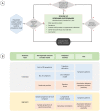Trends and symptoms of SARS-CoV-2 infection: a longitudinal study on an Alpine population representative sample
- PMID: 37290944
- PMCID: PMC10254957
- DOI: 10.1136/bmjopen-2023-072650
Trends and symptoms of SARS-CoV-2 infection: a longitudinal study on an Alpine population representative sample
Abstract
Objectives: The continuous monitoring of SARS-CoV-2 infection waves and the emergence of novel pathogens pose a challenge for effective public health surveillance strategies based on diagnostics. Longitudinal population representative studies on incident events and symptoms of SARS-CoV-2 infection are scarce. We aimed at describing the evolution of the COVID-19 pandemic during 2020 and 2021 through regular monitoring of self-reported symptoms in an Alpine community sample.
Design: To this purpose, we designed a longitudinal population representative study, the Cooperative Health Research in South Tyrol COVID-19 study.
Participants and outcome measures: A sample of 845 participants was retrospectively investigated for active and past infections with swab and blood tests, by August 2020, allowing adjusted cumulative incidence estimation. Of them, 700 participants without previous infection or vaccination were followed up monthly until July 2021 for first-time infection and symptom self-reporting: COVID-19 anamnesis, social contacts, lifestyle and sociodemographic data were assessed remotely through digital questionnaires. Temporal symptom trajectories and infection rates were modelled through longitudinal clustering and dynamic correlation analysis. Negative binomial regression and random forest analysis assessed the relative importance of symptoms.
Results: At baseline, the cumulative incidence of SARS-CoV-2 infection was 1.10% (95% CI 0.51%, 2.10%). Symptom trajectories mimicked both self-reported and confirmed cases of incident infections. Cluster analysis identified two groups of high-frequency and low-frequency symptoms. Symptoms like fever and loss of smell fell in the low-frequency cluster. Symptoms most discriminative of test positivity (loss of smell, fatigue and joint-muscle aches) confirmed prior evidence.
Conclusions: Regular symptom tracking from population representative samples is an effective screening tool auxiliary to laboratory diagnostics for novel pathogens at critical times, as manifested in this study of COVID-19 patterns. Integrated surveillance systems might benefit from more direct involvement of citizens' active symptom tracking.
Keywords: COVID-19; SARS-CoV-2; epidemiology; health policy.
© Author(s) (or their employer(s)) 2023. Re-use permitted under CC BY-NC. No commercial re-use. See rights and permissions. Published by BMJ.
Conflict of interest statement
Competing interests: None declared.
Figures




References
Publication types
MeSH terms
LinkOut - more resources
Full Text Sources
Medical
Miscellaneous
